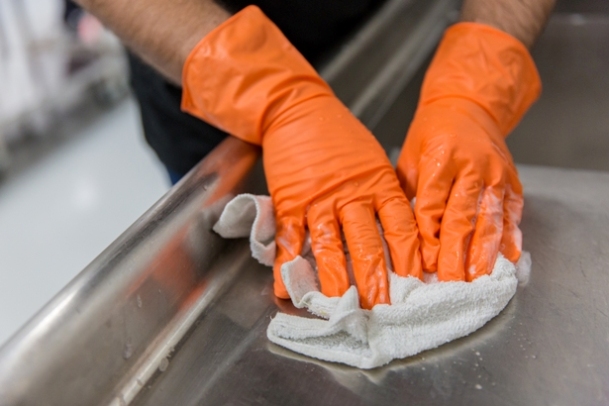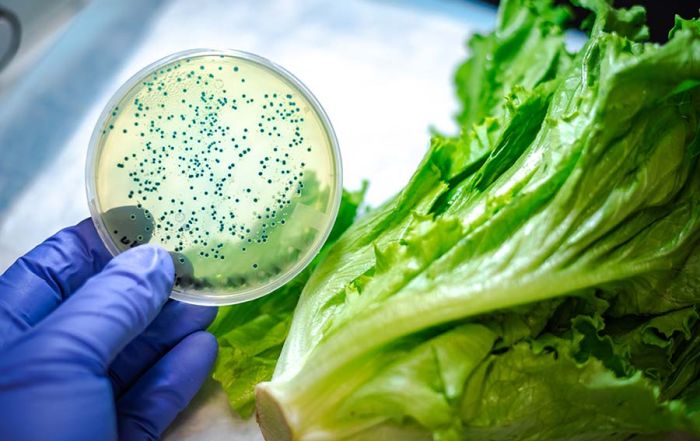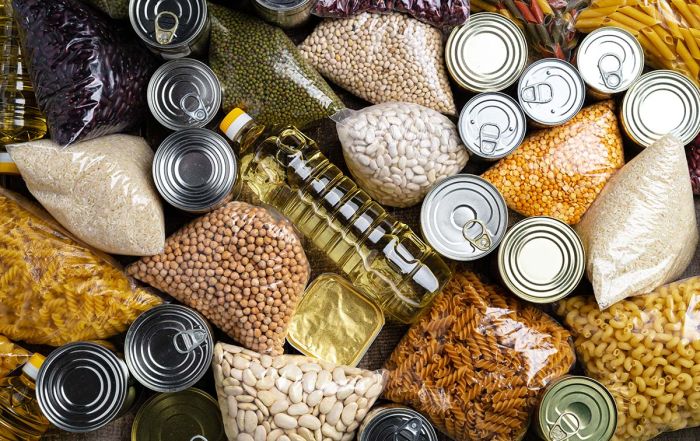Don’t Compromise: Clean and Sanitize
The subject is cleaning and sanitizing. Chefs, food service directors, managers and staff try to practice safe food-handling at every turn in the kitchen. Don’t let that effort go down the drain by slacking off on the many aspects of sanitation. That includes dish and ware-washing techniques (pots, pans, equipment), and cleaning all the areas that give us that “neat as a pin” appearance in your customers eyes. Customers seldom fail to bring that soiled silverware or glass with lipstick on it to the attention of the manager or wait staff. Improperly cleaning and sanitizing of food contact equipment does allow transmission of pathogenic microorganisms to food and ultimately our customer.
Cleaning vs. Sanitizing –Cleaning is the process of removing food and other types of soil from a surface (what you can see). Sanitizing is the process of reducing the number of microorganisms on a clean surface to safe levels (removing microorganisms you cannot see). Both can be done with heat or chemicals. Sometimes we misuse terms regarding sanitation, so to further clarify definitions for killing microorganisms, disinfection and sterilization methods are much higher levels of microorganism destruction than sanitizing. They are done by higher heat, higher chemical concentration or just stronger chemicals. Disinfection might be used for non-food contact surfaces such as floors or walls. Sterilization is used on medical equipment and some food processing equipment, but not in a kitchen environment.
Any surface that comes in contact with food such as a cutting board or utensil must be cleaned and sanitized:
- After each use of that piece of equipment.
- Anytime you begin working with another type of food – special care is needed between raw food and ready-to-eat food preparation.
- Anytime you are interrupted during a task and the tools or items you have been working with may have been contaminated. Busy rush periods or receiving deliveries might be examples.
- At four-hour intervals if the food contact equipment is in constant use. A good example is a deli slicer or knife, but hopefully you clean and sanitize heavily used equipment even more often than the 4 hour maximum to help control cross-contamination.
Dishwashing Machine Operation—For the best cleaning, start with the right equipment. Pots and pans usually need manual 3 compartment sink process. Dishes, glassware, and flatware are best washed in a commercial automatic dishwasher. Selection of the right machine depends on several factors, including the overall volume and type of wares to wash and sanitize. Dish machines range in size from single-tank, stationary-rack units to flight-type conveyor units. According to the National Association of Foodservice Equipment Manufacturers, dish machines are rated by the number of racks loaded with an average of 20 dishes that can be properly washed per hour. It’s critical to match the machines rating to your real-life dish count.
Operators can choose ‘high-temperature” or” low-temp” machines. High-temp sanitize using very hot water. Their rinse cycle must be at least180°F, although no higher than 194°F. Temperatures of 195°F and above can cause food particles to “bake” onto the dish surface from the steam. Machines using chemical sanitizers operate at lower temperatures (120°F) and use chlorine to sanitize that is injected into the final rinse. Even though machines are “automatic”, their efficiency is dependent upon the human factor – dish-room personnel, so remember these points:
- Check the machine for cleanliness at least once a day, cleaning it as necessary. Fill the tanks with clean water, clear the spray nozzles, and fill the detergent, rinse aid, and sanitizer dispensers properly.
- Scrape, rinse, or soak items before washing. Pre-soak items with dried on food particles.
- Load dish racks correctly and don’t overload them. Make sure all surfaces are exposed to the spray action of the machine.
- Check temperatures and pressure frequently following the manufacturer’s recommendations.
- Check each rack as it comes out of the machine for soiled items and run dirty items through again until they are clean.
- Air dry all items. Place glasses, cups, pots and pans upside down on the drying rack. Place and store flatware and utensils with handles up.
- Handwashing is important for the crew in the dish room if one person is loading dirty dishes and also removing clean dishes from racks. Train the crew how to best control this step.
Three Compartment Sinks –Pots, pans, utensils, and bar glassware are typically washed manually in a three-compartment sink. All sinks should be rinsed and cleaned prior to use. The first sink is for pre-soaking and washing. At least 110°F (as hot as you can stand) will help the detergent work. Before filling the second and third sinks, scrape any pots and pans that need presoaking and place them in the filled first sink. Those extra minutes in the hot water will help loosen the dried-on particles. Fill the second sink – the rinsing compartment—with warm water too (at least 110°F). Then fill the third sink – the sanitizing compartment. Measure your sanitizer accurately considering the gallons of water in the 3rd sink. Based on the sanitizer manufacturer’s recommendations and label instructions, use water temperature of 75°F to 120°F to sanitize. Do not rinse off the sanitizer. Air dry all equipment – do not towel dry.
Sanitizer effectiveness is based on three factors: 1) concentration of the solution in water; 2) water temperature; and 3) contact time with the dishes. Sanitizers must be EPA registered. Test kits are required by the FDA Food Code and the regulatory agency that inspects your facility. Chlorine and quaternary ammonium sanitizers are the most common in food service. Chlorine-based sanitizers should be 50-100 parts per million (ppm’s) concentration and contact time is 7 seconds or more. Quaternary based sanitizers are usually 150 to 200 ppm’s concentration and 30 seconds contact time. All chemical sanitizers have pros and cons regarding characteristics such as kindness to skin, staining, smell, ability to work in hard water, effects on metal, and cost per use, so ask your chemical supplier to help you make the right choice.
Some additional hints for the dishwashing process:
- Wear heavy-duty, longer length, nitrile pot sink gloves to protect your hands for dishwashing applications.
- Keep sanitizer test kits handy and occasionally check the temperature of the washing and sanitizing solutions.
- Change the rinse water whenever it becomes cloudy. Avoid just running hot water as the rinse step. It’s time-consuming and wasteful.
- Wash hands thoroughly before and after performing dishwashing duties.
Bottom Line: So, as the title says, “don’t compromise – clean and sanitize”.
***
About the Author: Lacie Thrall
Lacie Thrall passed away in early 2017 after a long illness. She dedicated her 35-year career to improving the health and well-being of others by promoting food safety best practices. Lacie worked in environmental health for 17 years before joining FoodHandler in 1997 as the Director of Safety Management. While at FoodHandler, she trained employees and customers on safe food handling practices, including proper hand hygiene and glove use. Later as a FoodHandler consultant, Lacie provided the foodservice industry with food safety information and advice through her blog on FoodHandler.com.
READ MORE POSTS
Enhancing Safety and Adding Flavor: The Role of Additives in your Food Supply
Last week, I ran across a post on Facebook from a childhood friend denouncing additives in [...]
E. Coli Outbreaks, The Gift that Keeps on Giving
Late in December, in response to possible E. coli contamination, we saw a recall issued for [...]
A Fresh Start: Recommitting Yourself and Your Business to Food Safety in 2024
As we get settled into the new year and leave the hustle and bustle of the [...]
Dry Food Storage – How Vital is it to Food Safety?
Whichever you decide, because some jurisdictions have more stringent requirements than the conference for food protection, check with your local health department to make sure they also recognize the exam before you pay for it.











